Introduction:
Langkawi, often called the ‘Jewel of Kedah’, is a group of islands off the northwestern coast of Malaysia near Thailand. The largest of these islands is also eponymously called Langkawi. This island draws a large number of Malaysian tourists mainly because it is a duty free island and has excellent connectivity from and to other major tourist destinations of Malaysia. This charming laid-back island also offers opportunities for yachting and snorkelling and is a perfect weekend getaway from the mainland of Malaysia and this island makes sure that the visitors are well taken care of – the locals are exceptionally friendly people who ensure this.
History:
Behind all the beaches and activities of this island is an interesting legend, the names of places on this island have been derived from which. According to Malay legends, in the olden days, humans were gigantic and capable of superhuman feats. Two such humans, Mat Raya and Mat Cincang were Kung Fu masters in a village on the island of Langkawi. They were bitter rivals from different Silat schools and were constantly competing with each other. Once the rivalry grew so intense, to an extent that the two masters started duelling each other, each determined to kill the other, but were stopped short by their friend, Mat Sawak. But as fate would have it, their children fell in love and decided to get married which made the parents put aside their differences and get together for the marriage. Unfortunately, during the marriage, they started fighting again, undeterred by Mat Sawak’s pleas. Their intense fighting uprooted many trees and damaged a lot of buildings too and caused the villagers cooking the feast for the marriage to run away. They then started fighting near the cooking utensils and pots; Mat Raya kicked the pots containing the boiling curry and the hot water, both of which flew into the sky in different directions.
The pot containing the gravy flew to the south and landed at a place now called Kuah (Gravy in Malay language) and the other containing hot water landed at Air Hangat (Hot water in Malay). The gravy from the pot landed on the ground and was sucked in at a place now called Kisap (Sucked up in Malay); the pieces of the pot at Belanga Pechah (Broken pot in Malay) and the ring-shaped handle at Selat Cincin (Ring Strait in Malay). They fought for three straight days until they were cursed by the village sorceress; she turned them both into mountains and their innocent pacifying friend, Mat Sawak, into a hill. Today these peaks are called Gunung Raya and Gunung Cincang and the hill in-between is Bukit Sawak. That is an interesting story for a Cambrian period rock formation dating 550 million years, sections of which have been made into a UNESCO Geopark – the Machinchang Cambrian Geoforest Park. It is one of the three major Geoparks of Langkawi – Kilim Karst, Machinchang Cambrian, Dayang Bunting.
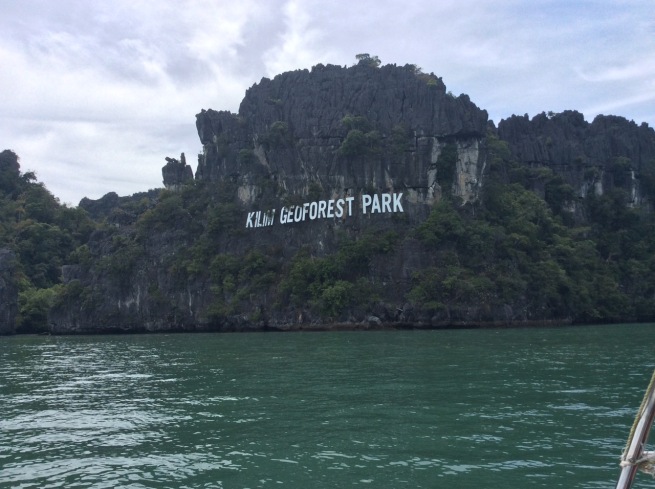
The island is one of the first parts of South-East Asia that rose from the seabed. While the names of places on this island themselves have been derived from a legend, the name Langkawi stands no lesser. The name, referenced in as early as 1405 by Chinese admiral Cheng Ho, has at least two theories about its origin. One is that it is derived from the words lang which is short for Kite in Malay and Kawi is a Reddish-brown, the colour of the kite (a Brahminy kite). This makes sense as kites roamed the skies of Langkawi and were abundant. The other theory of etymology is that Langkawi is derived from Lanka or Langkasuka (from Indian epic Ramayana). It was used by the Acehnese people of Indonesia for their pepper plantations in the 15th century, but it was mostly inhabited by the people of the Malay peninsula. It was an active site of trade throughout time till the 19th century when the Siamese occupation killed or enslaved the locals. Another legend has it that the island was cursed by a woman named Mahsuri who was unjustly accused of adultery and killed by the islanders. It is said that when she was killed, white blood flowed out of her corpse signifying her innocence; before death, she cursed Langkawi that it would not prosper for seven generations. It was then conquered consecutively by the Siamese, the Dutch, the British and even the Japanese before it was finally freed. It was not very prominent as a tourist location until the late 1980s. Coincidentally, the onset of tourists to Langkawi began sometime after the period of the curse was over.
Best season to visit:
Langkawi is an island in the equatorial belt and is humid throughout the year, though it does not receive too much of rainfall considering its distance from the equator. The island can be visited any time of the year, but the tourist season is between the months of January and March. Those wanting to scuba-dive should avoid the period between September and November.
How to reach:
Langkawi is well connected by flights from mainland Malaysia, Singapore and Thailand. There is also a ferry service from mainland Malaysia and Thailand. We chose the flight option as we were travelling from Kuala Lumpur, we travelled by Malindo which we found was the best option considering the free luggage limit of 15 kgs.
Tip: When travelling from Langkawi to mainland Malaysia, remember that there is a restriction on the amount of alcohol that you can carry. Get to know about it at the airport.
Accommodation:
Langkawi offers plenty of good accommodations at very reasonable prices. Choose one that is close to one of the major towns – Kuah, Pantai Cenang or Kedawang so you don’t waste time hunting for restaurants even though the entire island is not too very big.
We stayed at Kuala Melaka Inn as it was close to the airport and also Pantai Cenang. It was also budget friendly, offered excellent service and had a retail store in the building. This here was our room.

Languages spoken:
A variant of Kedah Malay is the most widely spoken language, although most shop owners understand English. Other languages spoken are Tamil and Siamese.
Food:
Us vegetarians (Yes, not vegans!) had no issue finding good vegetarian food; there are good Indian restaurants too. We found Indian, Malay, Chinese cuisines predominantly and the best part was that all were budget-friendly. We also ate at a Lebanese restaurant – Tarbosh Lebanon Restaurant – and found it particularly good. There is no shortage of international restaurants or cuisines on the island. Do try a dish – Bingka Ubi – which is also called Casanova cake. And don’t forget fruits – Durian and Dragon-fruit.
Transport:
Have no second thoughts, just get a rental car at any one of the counters at the airport and while you are at it, do not forget a free map. The roads are wide enough with absolutely no potholes or traffic, barring a few animals. We chose an automatic transmission which cost us 70 RM (Malaysian Ringgit) a day. You will need a valid driving licence for driving on the left side of the road. There are also other forms of transport such as motorbikes and chauffeur-driven cars and also taxis (which are hard to come by).
Sights and places to see:

The island abounds with beaches – lonely, crowded, sandy, rocky, you name it and you could find it. We spent a very limited amount of our time on beaches because they were not very exquisite. There was this Black Sand Beach which was on our way and we visited it twice – once during high tide and once during low tide. This beach is in the northern part of the island.

The most famous of the attractions is the Langkawi Cable Car, situated on Mount Chinchang, it also leads to the Langkawi Sky Bridge. It is situated in the northwest corner of the island in the Oriental Village and if the posters there are to be believed, it also has the steepest gradient (42°) in the world for a cable car. The entry is through the Oriental village which also houses other attractions such as Art in Paradise, a Duty Free Shop, Duck Tours amongst others. We skipped most of these places including the highly acclaimed 3D Art in Paradise and had a little snack at a German Bakery. It is a good idea to refresh yourself while you wait here for your time slot. To avoid the wait, go for the Express queue that costs RM 50 extra per person in addition to the RM 45 per person for the Cable Car ride. They do not operate the cable car if there is a strong wind blowing; which was precisely what happened when we visited, so we waited for nearly an hour before they resumed operations before waiting in the queue for at least 40 minutes. The worst part was that after this wait, we were taken to a boring 5D movie at the Sky Dome.The best part was that after the movie, we were taken to the boarding station, the sight of which renewed our energy. The frightening part was that there were glass-bottom cable cars which are sure to make you freak out. The way up takes around 15 minutes with one stop at a viewing platform, be sure to get down here. The 360° view from the platform is vividly colourful with an expanse of green trees on one side and a cloudy blue sea on the other. Also, there are refreshments and utilities here, but as expected, are priced slightly higher than normal.

We spent much of our time at the platform shutter-happy, but exhausted. We boarded the Cable Car headed to the top, appreciating the views of the Sky Bridge and the Seven Wells Waterfall along the way. We even took a daring selfie with our mobile phone outside the cable car knowing fully well that the mobile would not survive a 70m fall. And clear as the sky could be, Thailand was nowhere in sight and we later realised that this was a myth.
Tip : Refresh yourself here as there are no facilities available once you reach the bridge. Also, check the weather; if it is going to rain, then it is easier to find shelter at the top.
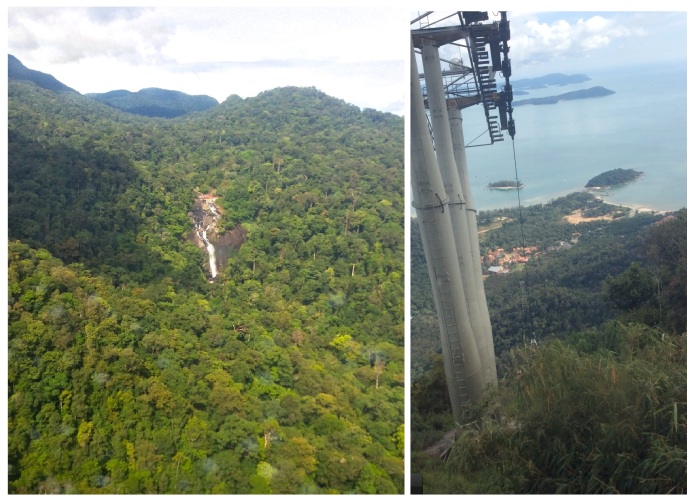

This ride was much shorter and we reached the top in no time at all. It costs RM 10 to visit the Langkawi Sky Bridge; the fee was for the Sky Train; it was under repair but they collected the amount anyway. Sky Train, as we were told, is an escalator of sorts and leads down to the Sky Bridge. After an arduous trek down a make-shift path, we reached the Sky Bridge, sweating and panting, only to be welcomed by a mild shower, accompanied by a fresh breeze.
The curved Sky Bridge is an incredible piece of architecture and so is the story of how it was built. It is supported by only one pylon (the pole) and the entire structure can hold upto 250 people at a time. Different portions of the bridge were assembled elsewhere and lifted by a helicopter to be placed here. The triangular areas at each end offer spectacular photo opportunities and we did not miss out on any.
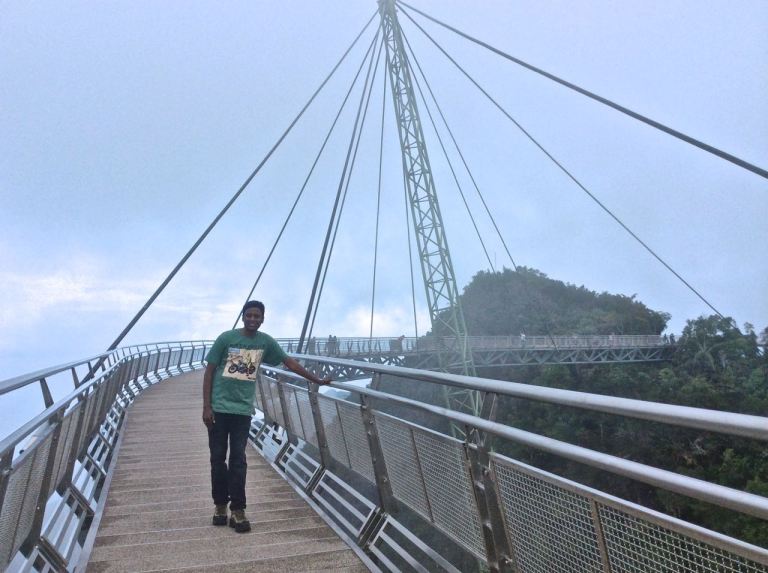
After spending nearly half the day at these two places, we realised we were running out of time (as always). We headed to the nearest destination which was the Langkawi Craft Complex, but it was closed and so we headed on to Air Hangat Village. Air Hangat Village has a hot spring with many separate jacuzzis as well. The entrance looked promising, but the moment we went inside, we realised that it was not worthwhile. The hot spring tank was downright dirty and had green algae floating in it and the water was hardly hot. Skip this place. We rushed out in five minutes and headed to Langkawi Wildlife Park and Bird Paradise which we hoped would be better, though we did not have much expectations as we had heard the place was not too good.The entrance fee was RM 28 per person and we were desperate to cross this off our list. This is a mini petting-zoo which has many birds and also animals. Turns out that not having much expectation from a place is a good thing as we had some fun here. Though it was small, it had very helpful staff and we definitely enjoyed our visit here. Do not expect to see any exotic birds here, but expect a lot of opportunities to feed and have a personal experience with the birds. There is an ostrich here that is very active and had it not been for a noisy couple nearby, it would have buried its head into the ground (Just kidding). The covered walkway was a great relief for us, though the heat did get to us. We might have spent half an hour here, but we got bored.

From here, we rushed out and headed to the Durian Perangin waterfall, stopping only for a brief visit to the Langkawi Black bee farm. The bee farm sells honey of black bees; they let you take shots of the mildly sour honey for a charge (10 RM). A quick stop here is definitely a good idea before the Durian Perangin waterfall. Small, scenic, with not much of a gushing sound, this falls was very pleasant and a welcome change from an otherwise hot, tiring day.

There is a flight of very slippery stairs leading to the top of the waterfall, with trees lining our path as we walked up. Locals told us that these trees are laden with Durian fruits in July, probably why the falls is named so. We went up the stairs and saw that there was another small pool at the top; locals told us that there were 14 such small pools or levels. We didn’t explore each level; if you do, please let us know your experience. It is said that there is a small path that leads up all the way to the peak of Mount Raya. We relaxed for some time and left when it was getting dark. We were on our way to Kuah when we chanced upon this temple Wat Koh Wanararm or Lucky Temple. It was dark and raining heavily by the time we reached there. We were unable to explore much as there was no electricity either in most parts of the temple. There was a statue of Buddha, which was the only discernible thing in the darkness.
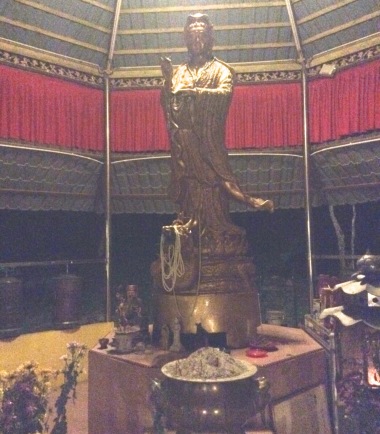
Drenched in the rain, we left for Kuah town, but our tyre got punctured by a nail. We tried changing the tyre in the rain, but it was quite difficult, it being our first time. Fortunately for us, a helpful local passed by and helped us change the tyre. He was headed somewhere, but still did not mind helping us out in the rain. We will never forget the help that he extended to us. Whoever you are, we will always be thankful to you.
The busy southern town of Kuah is sure to make you feel good with its brightly coloured buildings, the beautifully-lit streets and duty-free shopping malls. It is also home to the Eagle Square, Jetty Point, Taman Langenda, Langkawi Plaza, Langkawi Fair and a plethora of places to dine and shop. Considered the commercial centre of the island, there are many places to eat here, we had slight difficulty in finding a vegetarian restaurant, but this is only because the restaurants are grouped together according to the cuisines that they serve.
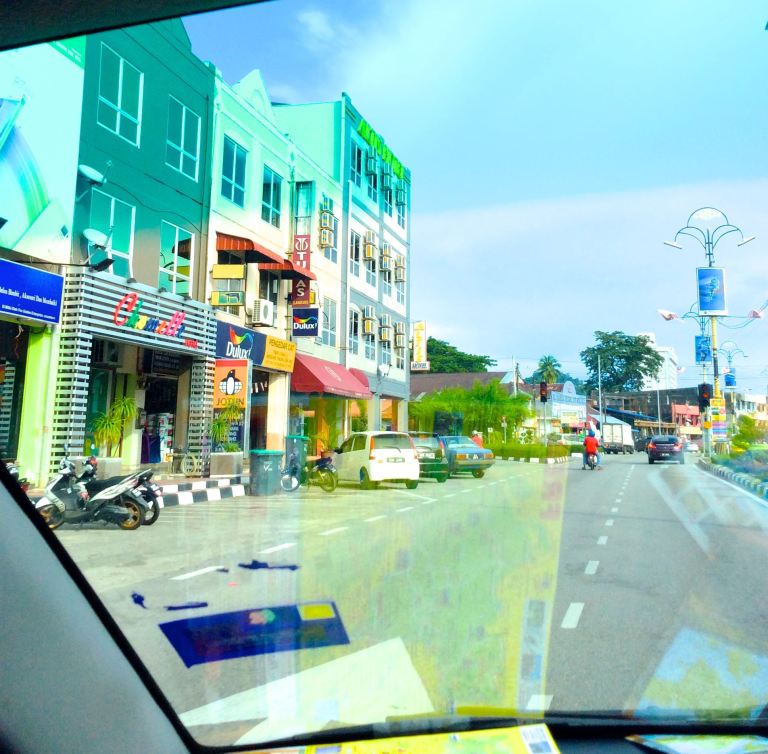
The Legends Park or Taman Legenda has the setup of a film city. There are so many statues depicting Langkawi’s interesting legends. Right from the entrance where there is a huge stone with a map of the islands to the interior, one can see that the park is not well-maintained, even though it is clean, quite possibly because of the RM 5 fee. This park is huge and takes at least two hours of your time. Most of the boards here have been damaged or ruined, if you want a good tour of Taman Legenda, we recommend you check this out. We rushed through the park as we were running short on time. We recommend you spend at least two full days in Langkawi and avoid a few places that we have asked you to so you can optimise your time and visit the good places.
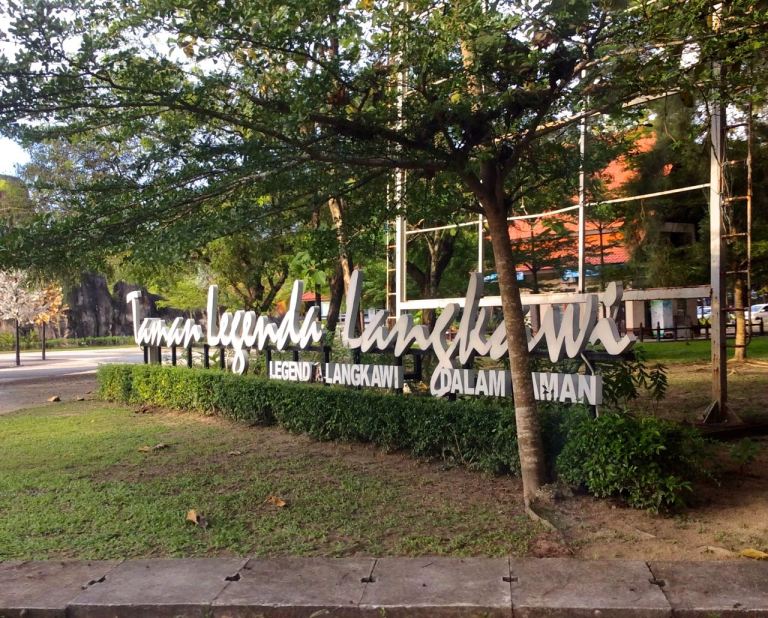
Just near the Taman Legenda is the Eagle Square. This is also the Jetty Point where the cruise ships and ferries dock. Ironically, there is a giant 12m statue of a Brahminy Kite (and not an Eagle) welcoming the visitors to the island; hence Eagle Square may actually be a misnomer. There is a RM 2 entry fee, but it is totally worth it, the view of the majestic kite is breathtaking and the cool winds that blow from all three sides rejuvenate you mind and body. The only thing that was getting to us here was that no matter the angle, we were unable to get a good photo.

While you are at Kuah, don’t forget to shop to your heart’s content at any of the duty-free shopping malls. We shopped at Billion in Langkawi Fair Mall and must have taken a billion chocolates; there is a significant difference in the prices of chocolates when compared to the Malaysian mainland and even more compared to India. To give you an idea of the prices, a bar of Toblerone here cost us RM 22, whereas the same costs around RM 90 back home, in India. Few famous malls are Jetty Point Complex, Kompleks HIG, Langkawi Plaza, Langkawi Parade. We were out of time and hence chose to skip the Al-Hana mosque and CHOGM park, which are near the Taman Legenda. A place to skip is the Galeria Perdana, which houses the gifts given to Tun Dr. Mahatir Mohammed. The only thing worth seeing here is the excellent architecture on the ceiling. Usually, museums are very informative and you get a feeling that you have learnt something new, but over here, we never felt there was anything informative, except the years of receipt of the gifts. Avoid this “Tourist-Trap”.

There are many activities in and around Langkawi that are offered as a package – Scuba and Snorkelling at Pulau Payar Marine Park, Mangrove tour at Kilim Karst Geoforest Park, Island Hopping from Kuah, Island Hopping from Pantai Cenang, Yachting, Trekking at Mount Raya, Jungle Trails. We chose the popular Mangrove Tour at Kilim Karst, it starts in the morning and lasts for around 3 hours. There were two other families who were with us and we negotiated the rate together. The itinerary included Bat Cave, Mangrove Forest, Fish Farm visit, Eagle Feeding and a visit to Gua Langsir, all by boat.
Tip: Reach around 9 in the morning and find more people to accompany you and negotiate the rate for one entire boat.
The Bat Cave or Gua Kelawar is definitely not the home of Batman (Sigh!), but is home to a few hundred of his friends. The cave has been formed by a fast flowing river through the rock here, as is evident from the rugged interiors of the cave. The floor here has literally been made of bat droppings hardened over the the course of time, which also means you will experience a strong odour. There are also huge stalactite and stalagmite depositions all around. The bats are mostly asleep during day and one can catch a sight of hundreds of bats asleep on the roof of the cave. One guide asked us to turn off the flash in our cameras inside the cave as it would disturb the bats, while another said the flash did not matter, but we had to keep our voices low. There were signboards placed at many places which helped visitors educate themselves about the bats and the cave as such.We got to know about the importance of bats in the island’s ecosystem and bats in general.
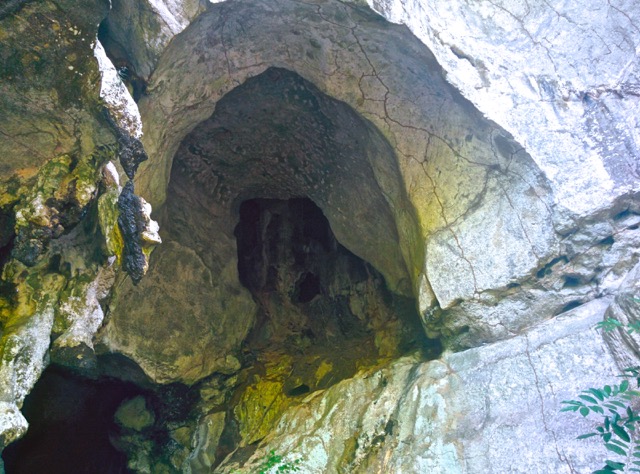
There was this special type of stalactite that was curved and not straight; it is almost as if it was alive. The reason for this type of growth was that the growth was influenced by a type of algae that lived on the deposits and required sunlight for photosynthesis. The rainwater deposits calcite minerals on the algae and since more algae is on the side where the exposure to sunlight is more, the stalactite bends in that direction, rendering in bent stalactites. Also, the rainwater dissolves limestone and releases carbon-dioxide which is used by the algae in photosynthesis, so there is a symbiotic relationship between the algae and the deposits.

As we exited the Bat Cave, we entered a thick Mangrove Forest, the water sheltered from sunlight and brown in colour. The forests here are a unique combination of limestone rocks and mangrove swamps and offer a wide variety of flora and fauna; they are hence visited by both tourists and researchers alike. The putrid smell of the cave was replaced by the smell of the swamp and it was actually better.
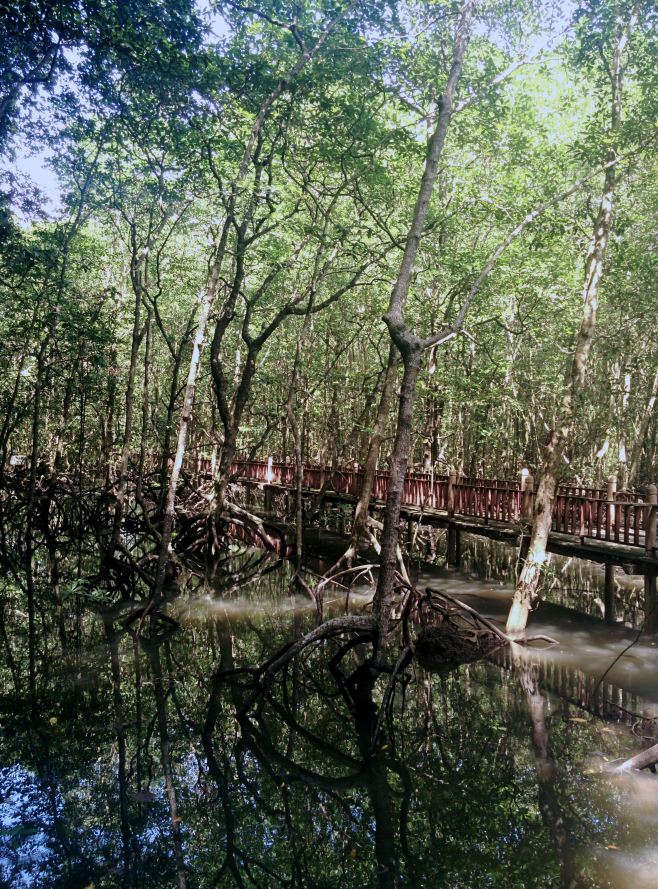
There are many caves in and around Langkawi worth visiting, a few are Crocodile cave, Porcupine cave, Cave of Legends, Cave of Banshee and Gua Pinang. They are mostly filled with bats and few have limestone formations, they are also mostly alike. For an off-the-track cave, do visit Gua Pinang, it is much larger than the Bat Cave and is supposed to have much better formations too. We visited Crocodile cave, (not a part of the Mangrove Tour package) but it was not accessible during high tide. It is named so because of the entrance which is shaped like a crocodile’s mouth, although it did not seem very appropriate.
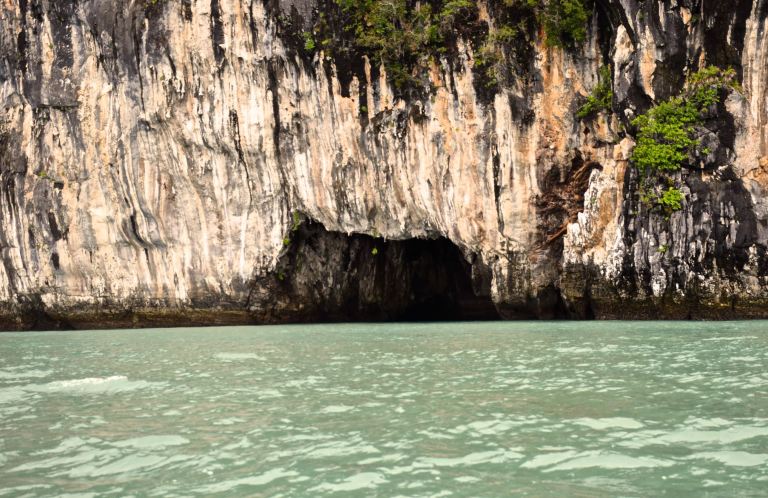
The tour took us further to a fish farm which also housed a floating restaurant. The animals were kept in really small ponds and it was sad to see them, but the owners assured us they were well-fed and taken care of. We had no choice but to believe them. The staff then led us to a stingray pit where we could feed them if we chose to. We watched them and listened to their instructions and did exactly as they asked us to. We also held Horseshoe Crabs and seahorses and saw Archer Fish in action. The Archer Fish is capable of shooting jets of water at its prey above the water level. The staff stick a piece of bread above the school of fish and the fish take turns squirting water at the target, when they hit the target correctly, it falls down and they eat it up. It is fun to watch them, but make sure to stand behind them or you could end up wet.
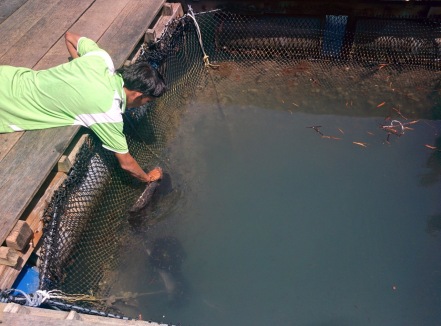
Some packages include a lunch too, but the menu consists exclusively of non-vegetarian food and so we did not go for it. We did not feed ourselves and went instead, to feed some eagles. And we will say this upfront, this entire activity is a waste of time. Sure, it is OK that you get to see some eagles and it is part of the package, but if you do have an option of negotiating the places, do skip this activity. We got to see many Brahminy Kites and one White-bellied Sea Eagle from afar. From here, we proceeded to Gua Langsir; there is a hidden lagoon in here which is accessible through a cave. There was a really small beach which we felt was our own private beach and we had some fun here.

There is a flight of stairs that leads up to the cave and another which leads down from the cave to a platform at the end of which is a brilliantly coloured green lagoon. The water here was so green and the greenery around made it seem like Greenland (Poor Pun). This place is very serene and we spent much time here just staring at the trees. We did this for ten minutes and would have done it for ten hours more had we not been interrupted by the boatman who was running late. We had to finish our tour and we did it with a huge meal at Kuah.
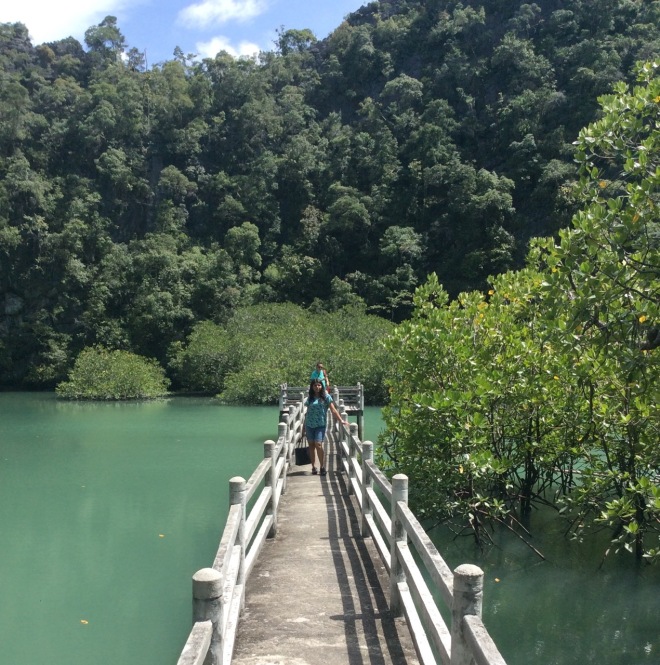
On the other side of the island, in Pantai Cenang, where the music goes on all night, is a place called Underwater World Langkawi. Since we had visited the KLCC aquarium at Kuala Lumpur just a couple of days before visiting Langkawi, this did not feature on our list, we skipped it. Judging by the pics posted online, we could say we did not miss much. There were a few other places that had “Tourist Trap” written all over them such as Mardi Agro Farm, Buffalo Farm, Crocodile Farm and Laman Padi. If you do visit these places, do let us know, we will be ready to change our opinion of these places.
We visited a lot many places in Langkawi, but there were many more and we felt we would go back there sometime, if not for all the chocolate, then at least for the caves that we left unexplored.
Terima Kasih, Langkawi !
Reference:
A book by Mohammed Zahir Haji Ismail and the helpful boards at Taman Legenda were very useful. For the latest updates, do follow this site.



Wow – looks like you got to do a million and one things in Langkawi. I was there about 15 years ago and I think I only ended up going to the beaches… But wow, what beaches! 🙌🏻😀 great Indepth info which will help if I return – thanks👍
LikeLiked by 1 person
Yep, the beaches were heavenly, we were there on our honeymoon, but it was hardly a honeymoon considering that we both spent most of our time travelling. And at the end, the only regret was that we wasted some time in those tourist traps and missed out on a few caves.
Thanks a lot for visiting. Enjoy your second trip to Langkawi. 🙂
LikeLiked by 1 person
Ah thanks -but I think it’s great you got to explore anyway… Most honeymoons people just lie on the beach and waste time not seeing a destination!
LikeLiked by 1 person
Exactly, we visited two countries and eight places on our honeymoon – Kuala Lumpur, Melaka, Langkawi, Jakarta, Yogyakarta, Bali, Makassar, Rantepao – and we plan on writing about these places too.
PS: We did also laze around in Bali.
LikeLiked by 1 person
What a unique honeymoon – I wouldn’t swap that experience for anything 😀
LikeLiked by 1 person
Neither would we. Lucky that we found each other. 🙂
LikeLiked by 1 person
Remember that in 20 years from now…
LikeLiked by 1 person
Excellent work done by you people.
LikeLiked by 1 person
thanks you very much, we strive to do our best.
LikeLike
Es ist wunderbar, brüder.
LikeLiked by 1 person
Danke, Prasanta.
LikeLike
The Island is so beautiful! It’s heaven.
LikeLiked by 1 person
It indeed is. 🙂
LikeLike
Wowwww..such a beautiful place..like “HEAVEN#…really thanx a lot yaswanth n tanu for dis great indepth knowledge ..it will be very helpful for me n manas..if we will plan to go dere..😍😍
LikeLiked by 1 person
Wow, what an adventurous life you lead! I’m not going to lie, I’m a little jealous… but your blog is great. I traveled through your words and for that,im grateful. Keep adventuring and writing!
If you’d like, you can check out my blog, here’s the link to my latest post http://wp.me/p7yzBE-6D, it’s off my typical topics so please feel free check out the rest of my site!
LikeLiked by 1 person
Thanks a lot for checking out our blog, of course, we will check our your blog.
LikeLiked by 1 person
Wow I went to Malaysia last year but I might have to go back again to visit Langkawi! It looks beautiful from the pics, and thank you so much for providing such a detailed account of your experience, it’ll be v. helpful if I do end up going. Love the honesty of your reviews and the tips.
I would say for the sights and places to see section, you could make each new attraction/place bold so that for someone skimming through quickly, they can stop at places which sound interesting to them.
Anyways, wishing you both the best of luck, and really looking forward to reading more of adventures!
LikeLiked by 1 person
Yeah, got it, great idea. We have put most places in the middle of sentences to break the monotonous tone. Thanks a lot for the helpful tip.
And if this post made you want to visit Langkawi, then mission accomplished. 🙂
LikeLike
Yeah I like that the places are in the middle of the sentence, it’s much more natural and makes it seem like we are travelling along with you!
Good luck with your travels and keep inspiring us!
LikeLiked by 1 person
Thanks a lot for your motivating comment. We will strive to inspire.
LikeLiked by 1 person
Machaan, sema da, very good description and pictures. Keep going da, all the best.
LikeLiked by 1 person
Thank you very much da… Glad you enjoyed it…
LikeLike
Wow – incredible. I’ve recently blogged all about Langkawi too https://worldwidewanderingblog.wordpress.com/2016/06/11/langkawi-malaysia/ but am in awe of all the things you’ve seen and done. Some stunning photos. Would love your thoughts on my post!
LikeLiked by 1 person
Great post, we enjoyed reading it very much.
LikeLiked by 1 person
Seems so beautiful! Nice pictures 🙂
LikeLiked by 1 person
Thanks a lot… We are currently traveling and are hence unable to write. Stay tuned for our next post on Yogyakarta
LikeLike
I will, have fun! 🙂
LikeLike
Very nice post! Loved it
LikeLiked by 1 person
Thanks a lot Priyanka, your website is also very nice and the pics you put up are simply fabulous.
LikeLike
This blog is useful in planning in trip. I thank you for the blog.
LikeLiked by 1 person
Thanks Chingsang. Happy to help.
LikeLike
Your blog was awesome. I will be reaching Malaysia the next week and am planning to backpack on my own. I will most probably be exploring Langkawi and hope to load myself up on chocolates.
LikeLiked by 1 person
Langkawi definitely is a must-visit. And go ahead, enjoy your chocolates. 🙂
LikeLike
Hi Yaswanth and Tanushree,
Nice blog with helpful information. The pics are also very well taken.
So this being a couple blog, how do you write each post? Does one of you write one post or what?
LikeLiked by 1 person
Hi Shrey,
Thanks a lot for stopping by.
This is a couple blog, so we kind of write together, one of us writes and then the other checks it to see if it can be framed in a better way and so on.
LikeLike
This seems a perfect paradise, I would like having an experience in a lush nature, surrounded only by the sound of the forest.
LikeLiked by 1 person
Langkawi offers that you want.
LikeLike
Wow!! Langkawi is a serious travel goals place. Thanks for providing the insights and I like that you included its History too.
LikeLiked by 1 person
Anytime. Do visit Langkawi instead of Thailand.
LikeLike
I am going there next week considering the short duration of our stay I don’t know if I will be able to cover all these places.I am going in langkawi only for one and a half days.
LikeLiked by 1 person
Oh. Great. Do not miss the Island tour and the ropeway. And load yourself up with chocolates, they are very cheap when compared to India.
LikeLiked by 1 person
It looks beautiful! I would love to have a private beach like that 🙂
LikeLiked by 1 person
It was heaven. We just loved the time that we spent there.
LikeLike
Looks like such a beautiful and magical place! Can’t wait to visit there!
LikeLiked by 1 person
Magical it is.
LikeLike
Nice post on this tropical paradise! Very useful tips and information for a first-time traveller. Good piece, thanks for sharing.
LikeLiked by 1 person
Thanks a lot. Hope this helps you plan your travel.
LikeLike
I linked to this post in one of my blog posts :
https://misstalkingfeet.wordpress.com/2017/07/22/wanderlost/
LikeLiked by 1 person
That is awesome!!! Feels good to be appreciated. Yay!!!!
LikeLike
Lovely photos!
LikeLiked by 1 person
Thank you!
LikeLike
Beautiful post! I spent a few days in Langkawi once and it wasnt enough!
http://www.josiearana.com
LikeLiked by 1 person